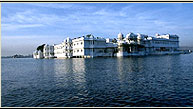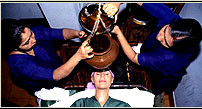-| Ellora | -
Location: District Aurangabad (Maharashtra) - Lat 20º 1'N, Long
75º 10 E

The hill, known after the neighbouring village of Verule or Ellora, is situated
about 25 kms. to the north west of Aurangabad. The hill, which is about 2 kms.
long in a line on the west face of the hill, contain caves in three groups -
Buddhist, Hindu and Jain. The caves run from south to the north. The southernmost
group is comprised of twelve Buddhist caves. These caves sprang up mostly in
the reign of early western Chalukya Dynasty (6th century to 8th century AD)
and partly in the early part of the reign of their supplanter, the Rashrakuta
dynasty rulers. The Buddhist caves have been identified as “the last bright
flame” of the Buddhist rock cut architecture. These caves have certain
original features being excavated on a gigantic scale not found elsewhere with
wide aesthetic vision exhibited by the excavators. Sculptors of Ajanta have
their downfall at Ellora.
Most of the caves were originally painted but now little faint traces of painting
exist. The exuberance of sculptured figures, which was rampant in the caves
of Aurangabad was carried further in abundance in these caves. The door of the
shrine chambers are always flanked by towering Boddhisattava, often in the company
of other figures. The cave 1 is an austerely plain monastery with a pillared
portico having cells at the ends. Cave 2 has individualistic treatment. Cave
3 has the full fledged monastic plan with the usual image of Buddha in the shrine.
The cave 4 is a plain astylar hall with a pillared aisle at the back leading
to shrine. The cave 5 is exceptionally spacious oblong hall. Cave 10 is the
last noteworthy attempt of the chaitya griha in the live rock and is locally
known as Vishvakarma after the architect (ancient Hindu God) . The remaining
two caves - the latest Buddhist excavation at the Ellora, are unique in conception
and remarkable for their originality of composition. These caves consist of
three storeyed edifice with a spacious forecourt - approached through a passage
cut into the front hall.
The Ellora is the unique example of survival of three religious edifices (Buddhist,
Hindu and Jain) side by side.




